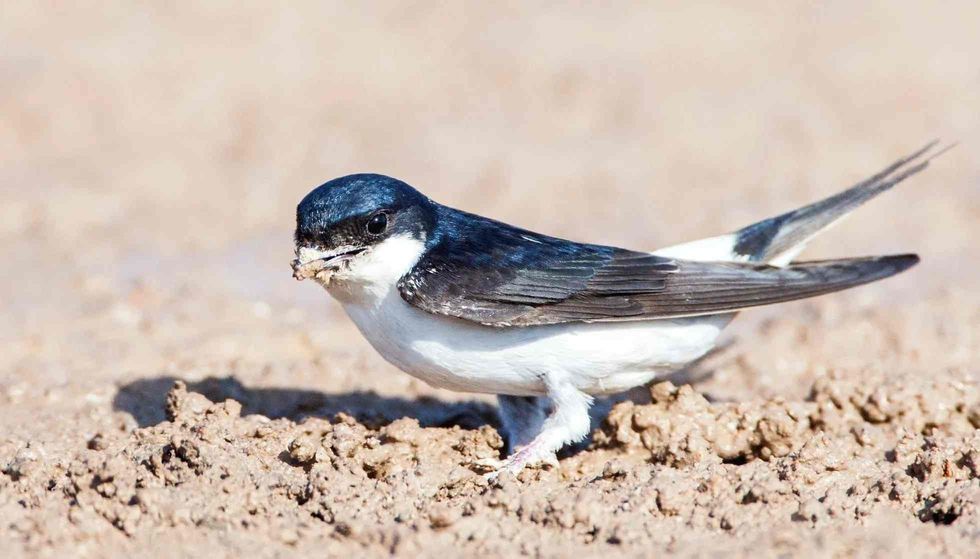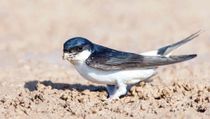The common house martin (Delichon urbicum) is also called the northern house martin. It belongs to the order Passeriformes family Hirundinidae.
These birds are commonly found in Europe, North Africa, Palearctic, Sub Saharan Africa, and Asia. The common house martin of genus Delichon has recently been diverted as a separate species from the barn swallows, from Europe, of genus Hirundo urbica.
The common house martin has two subspecies viz D. u. Urbicum, the western subspecies, and D. u. Lagopodous, the eastern subspecies.
Their breeding grounds are different. These birds eat flying insects the most in march when their reproduction is near. The reproduction of common house martins occurs two times a year.
Read on to know more about this species of birds. After reading about this bird from Asia, you may also look at our articles on the vulture guineafowl and martial eagle.
Common House Martin Interesting Facts
What type of animal is a common house martin?
A common house martin from the order Passeriformes family Hirundinidae is a bird. Martins can be found in European cities and are often seen together in a flock.
What class of animal does a common house martin belong to?
A common house martin of genus Delichon belongs to the bird class of animals.
How many common house martin are there in the world?
There are estimated to be around 48 million northern house martins in the world.
Where does a common house martin live?
A common house martin habitat is in the woods of sub-saharan Africa. They prepare their nests in the mud.
What is a common house martin's habitat?
A common house martin lives in open and semi-open habitats. The nesting sites of these birds include pastures, meadows, and farmlands. In some instances, the species is spotted even in the mountains.
They prefer to build their mud pellets nests, in march, near water sources. That is to ensure they have an abundant water supply during the nesting period. Their nests are shaped like an upside-down concave surface.
They sleep in their nests. Some cliff-nesting colonies are also found.
Apart from the wilds, this species also builds nests near buildings, roofs, and sheds. Unlike barn swallows, the northern house martin prefers urban habitats. The Eastern subspecies are usually found in the east and the Western subspecies are found in the west.
Who do common house martins live with?
A northern house martin lives in colonies with other birds of their species. Small colonies range from 3-10 nests, whereas large colonies can have up to 1,000 nests.
How long does a common house martin live?
A common house martin lives for around two years. That is pretty average for the birds of flight in this family.
How do they reproduce?
Common house martins are monogamous birds, this species conduct breeding with the same partner for life. But extra-pair copulations are observed widely in this species when the males leave the nest. The breeding season of these birds usually starts in March.
Before the breeding season starts, the males and females of a couple build a nest together in March to lay eggs. The wintering grounds are situated in eastern and western Africa.
There can be two broods in a year. The common house martin eggs have an incubation period of 14-16 days. Both martins’ parents take care of the young one until the winter ends since the newborn is not capable of surviving the winter cold on its own.
What is their conservation status?
The conservation status of this species is Least Concern as their population is quite stable in the wild.
Common House Martin Fun Facts
What do common house martins look like?
The physical description of common house martins is as follows. Common house martins have a steel blue upper part of their body. Their wings are almost completely blue.
The lower part is pure white in color. Their beak is short, thin, and black in color. They have a white rump which is very prominent.
Their legs and toes are covered in white feathers. This species has small brown colored eyes and a forked tail which is shallower than the swallows. Common House Martins resemble the Nepal House Martins, from Asia, very closely.
How cute are they?
Common house martins are very cute birds. Their color aesthetic is excellent and they look very beautiful. Their small size adds to their cuteness.
How do they communicate?
Common house martins have different sounds where each sound has a specific meaning. On encountering danger, the northern house martins raise alarm calls which sound like 'tsitsitsitsier'.
Apart from that, their usual sounds are 'prrrrt' and 'pri-pit', which they use for the description of situations. They also have a specific sound for the breeding season to attract a mate for breeding. The calls of these breeds are not that loud.
How big is a common house martin?
A common house martin is a small bird. Their length is usually around 5.1 in (12.95 cm). They are smaller than sparrows but at least five times bigger than bees. They are in between barn martins and swallows in size.
How fast can a common house martin fly?
A common house martin can fly at the speed of 24.5 mph (39.4 kph). Their light wings allow swift flight. They bend their wings backward to gain speed during the flight.
How much does a common house martin weigh?
An adult, common house martin weight, ranges between 0.6-0.7 oz (0.017-0.019 kg).
What are the male and female names of the species?
There are no specific names given to the males and females of the common house martin species. They are known as males and females respectively.
What would you call a baby common house martin?
A baby, common house martin, can be called a chick.
What do they eat?
The common house martin diet most commonly includes flying insects. The flying insects also include flying ants.
Are they dangerous?
Common house martins are not dangerous to humans. They hardly bother humans but are protective of their nests. Humans usually do not disturb their nests.
Would they make a good pet?
The common house martin would definitely make a good pet. Martins need a proper diet and nutrition, and good habitat. Make sure you keep your martin safe from other pets.
Did you know...
The breeding (wintering) grounds of common house martins are situated in Africa.
In Europe, a common house martin is just called house martin.
Common house martins are hunted by the Eurasian hobby.
Common house martins return to the same nesting places every year.
Swallows look very similar to the common house martins.
This species is known to hybridize with the barn swallow. But these birds are more urban as compared to the barn swallow and have a shallower tail fork.
What is a group of house martins called?
A group of house martins is called a colony or a richness.
How long does it take a house martin to build a nest?
It usually takes around two weeks to build a new common house martin nest from scratch. The nest is built with soft mud pellets from ponds. The mud pellets are lined to make it softer with grass and feathers. The shape of the nest is half-spherical with a small opening at the top.
Here at Kidadl, we have carefully created lots of interesting family-friendly animal facts for everyone to discover! Learn more about some other birds from our green-winged teal facts and smew facts pages.
You can even occupy yourself at home by coloring in one of our free printable common house martin coloring pages.









